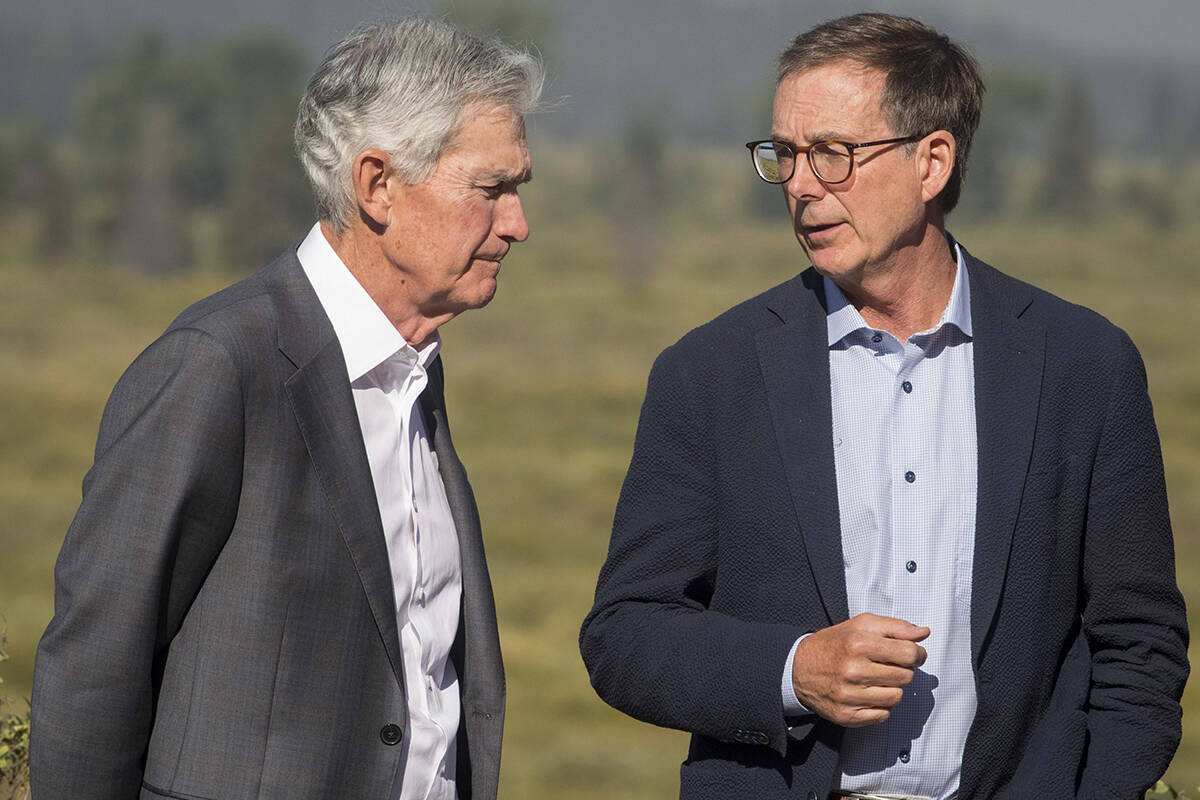‘The time has come’ for the Fed to soon begin reducing interest rates, Powell says
JACKSON, Wyoming — With inflation nearly defeated and the job market cooling, the Federal Reserve is prepared to start cutting its key interest rate from its current 23-year high, Chair Jerome Powell said Friday.
Powell did not say when rate cuts would begin or how large they might be, but the Fed is widely expected to announce a modest quarter-point cut in its benchmark rate when it meets in mid-September.
“The time has come for policy to adjust,” Powell said in his keynote speech at the Fed’s annual economic conference in Jackson Hole, Wyoming. “The direction of travel is clear, and the timing and pace of rate cuts will depend on incoming data, the evolving outlook, and the balance of risks.”
His reference to multiple rate cuts was the only hint that a series of reductions is likely, as economists have forecast. Powell stressed that inflation, after the worst price spike in four decades inflicted pain on millions of households, appears largely under control. According to the Fed’s preferred measure, inflation fell to 2.5% last month, far below its peak of 7.1% two years ago and only slightly above the central bank’s 2% target level.
“My confidence has grown,” he said, “that inflation is on a sustainable path back to 2%.”
The Fed chair’s assurance that rate cuts are coming helped fuel a rally on Wall Street. Bond yields fell and stock indexes were broadly higher.
“The only question remaining for the Sept. 18 meeting is: By how much will the Fed be cutting?” said Joseph LaVorgna, chief economist at SMBC Nikko Securities.
“The outcome of the August employment report,” which will be reported Sept. 6, LaVorgna said, “is obviously critical.” If that report shows a second straight month of weak hiring, the Fed may cut its key rate by a more aggressive half-point.
Predicting cut
Most economists expect the Fed to cut its benchmark rate by a quarter-point at each of its final three meetings this year. Wall Street traders, though, foresee a one-in-three likelihood that the Fed will cut by a half-point at one of those meetings, according to futures prices. A lower Fed benchmark rate will lead eventually to lower rates for auto loans, mortgages and other forms of consumer borrowing and could also boost stock prices.
In his remarks Friday, the Fed chair suggested that rate cuts should help extend the much sought-after “soft landing,” whereby inflation falls back to the Fed’s 2% target without a recession occurring.
Continued growth could boost Vice President Kamala Harris’ presidential campaign, even as most Americans say they’re dissatisfied with the Biden-Harris administration’s economic record, largely because average prices remain far above where they were before the pandemic.
“We will do everything we can,” Powell said, “to support a strong labor market as we make further progress toward price stability.”
By cutting rates, he said, “there is good reason to think that the economy will get back to 2% inflation while maintaining a strong labor market.”
A rate cut in mid-September, coming less than two months before the presidential election, could bring some unwelcome political heat on the Fed, which seeks to avoid becoming entangled in election-year politics. Former President Donald Trump has argued that the Fed shouldn’t cut rates so close to an election. But Powell has repeatedly underscored that the central bank would make its rate decisions based purely on economic data, without regard to the political calendar.
In his remarks, Powell said the Fed has grown concerned about slower hiring and a rising unemployment rate, even while it still wants to see inflation fall further. That dual focus is replacing the Fed’s previous singular focus on inflation.
“The cooling in labor market conditions is unmistakable,” the Fed chair said. “Job gains remain solid but have slowed this year. … We do not seek or welcome further cooling in labor market conditions.”
Victory lap
In what amounted to something of a victory lap, Powell noted in his speech that the Fed had succeeded in conquering high inflation without causing a recession or a sharp rise in unemployment, which many economists had long predicted.
The soft landing “did come as a big surprise to the (economics) profession,” Gauti Eggertson, an economist at Brown University, said during a presentation Friday at the Jackson Hole conference.
He attributed that outcome to the unraveling of the pandemic’s disruptions to supply chains and labor markets and a reduction in job vacancies, which allowed wage growth to cool.
Powell also noted that, according to surveys and financial market gauges, Americans never really expected high inflation to stick. Such expectations can become self-fulfilling: If people expect inflation to stay high, they typically demand ever-higher pay or they accelerate their purchases before prices rise still further. Those steps can perpetuate higher inflation.
But “inflation expectations” rose only modestly and have since largely fallen back to pre-pandemic levels.
“The healing from pandemic distortions,” the Fed’s rate hikes and the fact that Americans did not expect higher inflation, “have worked together to put inflation on what increasingly appears to be a sustainable path to our 2% objective,” the Fed chair said.
Powell also addressed criticism that the Fed was too slow to raise rates even after inflation had begun surging once the pandemic recession ended. Fed officials had initially argued that the price spikes coming out of the pandemic in early 2021 were merely “transitory” and would soon fade as the supply chain disruptions that left some grocery shelves bare and auto lots empty had healed.
He acknowledged that the healing of supply disruptions took much longer than the Fed had expected — and so did the persistence of high inflation.
“The good ship transitory was a crowded one, with most mainstream analysts and advanced-economy central bankers on board,” Powell said. “I think I see some ship-mates out there today,” he said, in an ad-libbed remark addressed to the economists and central banks assembled for the conference.
























